Target Information
| Target General Information | Top | |||||
|---|---|---|---|---|---|---|
| Target ID |
T84703
(Former ID: TTDNR00649)
|
|||||
| Target Name |
BDNF/NT-3 growth factors receptor (TrkB)
|
|||||
| Synonyms |
Tropomyosin-related kinase B; TrkB tyrosine kinase; Trk-B; TRKB; Neurotrophic tyrosine kinase receptor type 2; GP145-TrkB
Click to Show/Hide
|
|||||
| Gene Name |
NTRK2
|
|||||
| Target Type |
Successful target
|
[1] | ||||
| Disease | [+] 2 Target-related Diseases | + | ||||
| 1 | Non-small-cell lung cancer [ICD-11: 2C25] | |||||
| 2 | Solid tumour/cancer [ICD-11: 2A00-2F9Z] | |||||
| Function |
Receptor for BDNF/brain-derived neurotrophic factor and NTF4/neurotrophin-4. Alternatively can also bind NTF3/neurotrophin-3 which is less efficient in activating the receptor but regulates neuron survival through NTRK2. Upon ligand-binding, undergoes homodimerization, autophosphorylation and activation. Recruits, phosphorylates and/or activates several downstream effectors including SHC1, FRS2, SH2B1, SH2B2 and PLCG1 that regulate distinct overlapping signaling cascades. Through SHC1, FRS2, SH2B1, SH2B2 activates the GRB2-Ras-MAPK cascade that regulates for instance neuronal differentiation including neurite outgrowth. Through the same effectors controls the Ras-PI3 kinase-AKT1 signaling cascade that mainly regulates growth and survival. Through PLCG1 and the downstream protein kinase C-regulated pathways controls synaptic plasticity. Thereby, plays a role in learning and memory by regulating both short term synaptic function and long-term potentiation. PLCG1 also leads to NF-Kappa-B activation and the transcription of genes involved in cell survival. Hence, it is able to suppress anoikis, the apoptosis resulting from loss of cell-matrix interactions. May also play a role in neutrophin-dependent calcium signaling in glial cells and mediate communication between neurons and glia. Receptor tyrosine kinase involved in the development and the maturation of the central and the peripheral nervous systems through regulation of neuron survival, proliferation, migration, differentiation, and synapse formation and plasticity.
Click to Show/Hide
|
|||||
| BioChemical Class |
Kinase
|
|||||
| UniProt ID | ||||||
| EC Number |
EC 2.7.10.1
|
|||||
| Sequence |
MSSWIRWHGPAMARLWGFCWLVVGFWRAAFACPTSCKCSASRIWCSDPSPGIVAFPRLEP
NSVDPENITEIFIANQKRLEIINEDDVEAYVGLRNLTIVDSGLKFVAHKAFLKNSNLQHI NFTRNKLTSLSRKHFRHLDLSELILVGNPFTCSCDIMWIKTLQEAKSSPDTQDLYCLNES SKNIPLANLQIPNCGLPSANLAAPNLTVEEGKSITLSCSVAGDPVPNMYWDVGNLVSKHM NETSHTQGSLRITNISSDDSGKQISCVAENLVGEDQDSVNLTVHFAPTITFLESPTSDHH WCIPFTVKGNPKPALQWFYNGAILNESKYICTKIHVTNHTEYHGCLQLDNPTHMNNGDYT LIAKNEYGKDEKQISAHFMGWPGIDDGANPNYPDVIYEDYGTAANDIGDTTNRSNEIPST DVTDKTGREHLSVYAVVVIASVVGFCLLVMLFLLKLARHSKFGMKGPASVISNDDDSASP LHHISNGSNTPSSSEGGPDAVIIGMTKIPVIENPQYFGITNSQLKPDTFVQHIKRHNIVL KRELGEGAFGKVFLAECYNLCPEQDKILVAVKTLKDASDNARKDFHREAELLTNLQHEHI VKFYGVCVEGDPLIMVFEYMKHGDLNKFLRAHGPDAVLMAEGNPPTELTQSQMLHIAQQI AAGMVYLASQHFVHRDLATRNCLVGENLLVKIGDFGMSRDVYSTDYYRVGGHTMLPIRWM PPESIMYRKFTTESDVWSLGVVLWEIFTYGKQPWYQLSNNEVIECITQGRVLQRPRTCPQ EVYELMLGCWQREPHMRKNIKGIHTLLQNLAKASPVYLDILG Click to Show/Hide
|
|||||
| 3D Structure | Click to Show 3D Structure of This Target | AlphaFold | ||||
| HIT2.0 ID | T07S0E | |||||
| Drugs and Modes of Action | Top | |||||
|---|---|---|---|---|---|---|
| Approved Drug(s) | [+] 2 Approved Drugs | + | ||||
| 1 | Entrectinib | Drug Info | Approved | Non-small-cell lung cancer | [2] | |
| 2 | Larotrectinib | Drug Info | Approved | Solid tumour/cancer | [3] | |
| Clinical Trial Drug(s) | [+] 1 Clinical Trial Drugs | + | ||||
| 1 | MK-2461 | Drug Info | Phase 1/2 | Alzheimer disease | [4] | |
| Patented Agent(s) | [+] 5 Patented Agents | + | ||||
| 1 | 3-amino-5-benzyl-substituted indazole derivative 1 | Drug Info | Patented | Pruritus | [5] | |
| 2 | Macrocycle derivative 13 | Drug Info | Patented | Cell proliferative disorder | [6] | |
| 3 | PMID28270021-Compound-WO2015042088Example4 | Drug Info | Patented | Pruritus | [5] | |
| 4 | PMID28270021-Compound-WO2016054807Example1 | Drug Info | Patented | Pruritus | [5] | |
| 5 | Pyrrolo[2,3-d]pyrimidine derivative 4 | Drug Info | Patented | Pruritus | [5] | |
| Mode of Action | [+] 2 Modes of Action | + | ||||
| Inhibitor | [+] 15 Inhibitor drugs | + | ||||
| 1 | Entrectinib | Drug Info | [2] | |||
| 2 | Larotrectinib | Drug Info | [1] | |||
| 3 | MK-2461 | Drug Info | [4] | |||
| 4 | 3-amino-5-benzyl-substituted indazole derivative 1 | Drug Info | [5] | |||
| 5 | Cyclopenta[d]pyrimidine derivative 1 | Drug Info | [6] | |||
| 6 | Macrocycle derivative 13 | Drug Info | [6] | |||
| 7 | PMID28270010-Compound-Figure24-b | Drug Info | [6] | |||
| 8 | PMID28270010-Compound-Figure5-1 | Drug Info | [6] | |||
| 9 | PMID28270010-Compound-Figure5-2 | Drug Info | [6] | |||
| 10 | PMID28270021-Compound-WO2015042088Example4 | Drug Info | [5] | |||
| 11 | PMID28270021-Compound-WO2016054807Example1 | Drug Info | [5] | |||
| 12 | Pyrrolo[2,3-d]pyrimidine derivative 4 | Drug Info | [5] | |||
| 13 | AZD1332 | Drug Info | [7] | |||
| 14 | GNF-5837 | Drug Info | [8] | |||
| 15 | PMID24432909C8e | Drug Info | [9] | |||
| Modulator | [+] 1 Modulator drugs | + | ||||
| 1 | TrkB NAM | Drug Info | [7] | |||
| Cell-based Target Expression Variations | Top | |||||
|---|---|---|---|---|---|---|
| Cell-based Target Expression Variations | ||||||
| Drug Binding Sites of Target | Top | |||||
|---|---|---|---|---|---|---|
| Ligand Name: GW-2580 | Ligand Info | |||||
| Structure Description | CRYSTAL STRUCTURE OF TRKB KINASE DOMAIN IN COMPLEX WITH GW2580 | PDB:4AT5 | ||||
| Method | X-ray diffraction | Resolution | 1.71 Å | Mutation | No | [10] |
| PDB Sequence |
GAMDTFVQHI
549 KRHNIVLKRE559 LGEGAFGKVF569 LAECYNLKIL584 VAVKTLKDAS594 DNARKDFHRE 604 AELLTNLQHE614 HIVKFYGVCV624 EGDPLIMVFE634 YMKHGDLNKF644 LRAHGPDAVL 654 MAEGNPPTEL664 TQSQMLHIAQ674 QIAAGMVYLA684 SQHFVHRDLA694 TRNCLVGENL 704 LVKIGDFGMS714 RDVYSTDYYR724 VGGHTMLPIR734 WMPPESIMYR744 KFTTESDVWS 754 LGVVLWEIFT764 YGKQPWYQLS774 NNEVIECITQ784 GRVLQRPRTC794 PQEVYELMLG 804 CWQREPHMRK814 NIKGIHTLLQ824 NLAKASPVYL834 DILG
|
|||||
|
|
LEU560
4.106
VAL568
4.495
ALA586
3.326
LYS588
4.046
LEU608
3.755
LEU611
3.701
ILE616
3.730
VAL617
3.457
PHE633
3.443
GLU634
2.888
TYR635
3.444
MET636
2.938
|
|||||
| Ligand Name: (R)-3-((6,7,8,9-Tetrahydro-5H-benzo[7]annulen-5-yl)thio)-5-ureidoisothiazole-4-carboxamide | Ligand Info | |||||
| Structure Description | CRYSTAL STRUCTURE OF TRKB KINASE DOMAIN IN COMPLEX WITH CPD5N | PDB:4AT3 | ||||
| Method | X-ray diffraction | Resolution | 1.77 Å | Mutation | No | [10] |
| PDB Sequence |
GAMDTFVQHI
549 KRHNIVLKRE559 LGEGAFGKVF569 LAECYNLCKI583 LVAVKTLASD595 NARKDFHREA 605 ELLTNLQHEH615 IVKFYGVCVE625 GDPLIMVFEY635 MKHGDLNKFL645 RAHGPDAVLM 655 ANPPTELTQS667 QMLHIAQQIA677 AGMVYLASQH687 FVHRDLATRN697 CLVGENLLVK 707 IGDFGMSRYS719 TDYYRVGGHT729 MLPIRWMPPE739 SIMYRKFTTE749 SDVWSLGVVL 759 WEIFTYGKQP769 WYQLSNNEVI779 ECITQGRVLQ789 RPRTCPQEVY799 ELMLGCWQRE 809 PHMRKNIKGI819 HTLLQNLAKA829 SPVYLDILG
|
|||||
|
|
LEU560
3.745
GLY561
4.157
PHE565
3.332
VAL568
3.999
ALA586
3.317
LYS588
4.259
VAL617
4.147
PHE633
3.593
GLU634
2.974
TYR635
3.588
MET636
2.735
|
|||||
| Click to View More Binding Site Information of This Target with Different Ligands | ||||||
| Different Human System Profiles of Target | Top |
|---|---|
|
Human Similarity Proteins
of target is determined by comparing the sequence similarity of all human proteins with the target based on BLAST. The similarity proteins for a target are defined as the proteins with E-value < 0.005 and outside the protein families of the target.
A target that has fewer human similarity proteins outside its family is commonly regarded to possess a greater capacity to avoid undesired interactions and thus increase the possibility of finding successful drugs
(Brief Bioinform, 21: 649-662, 2020).
Human Tissue Distribution
of target is determined from a proteomics study that quantified more than 12,000 genes across 32 normal human tissues. Tissue Specificity (TS) score was used to define the enrichment of target across tissues.
The distribution of targets among different tissues or organs need to be taken into consideration when assessing the target druggability, as it is generally accepted that the wider the target distribution, the greater the concern over potential adverse effects
(Nat Rev Drug Discov, 20: 64-81, 2021).
Human Pathway Affiliation
of target is determined by the life-essential pathways provided on KEGG database. The target-affiliated pathways were defined based on the following two criteria (a) the pathways of the studied target should be life-essential for both healthy individuals and patients, and (b) the studied target should occupy an upstream position in the pathways and therefore had the ability to regulate biological function.
Targets involved in a fewer pathways have greater likelihood to be successfully developed, while those associated with more human pathways increase the chance of undesirable interferences with other human processes
(Pharmacol Rev, 58: 259-279, 2006).
Biological Network Descriptors
of target is determined based on a human protein-protein interactions (PPI) network consisting of 9,309 proteins and 52,713 PPIs, which were with a high confidence score of ≥ 0.95 collected from STRING database.
The network properties of targets based on protein-protein interactions (PPIs) have been widely adopted for the assessment of target’s druggability. Proteins with high node degree tend to have a high impact on network function through multiple interactions, while proteins with high betweenness centrality are regarded to be central for communication in interaction networks and regulate the flow of signaling information
(Front Pharmacol, 9, 1245, 2018;
Curr Opin Struct Biol. 44:134-142, 2017).
Human Similarity Proteins
Human Tissue Distribution
Human Pathway Affiliation
Biological Network Descriptors
|
|
|
Note:
If a protein has TS (tissue specficity) scores at least in one tissue >= 2.5, this protein is called tissue-enriched (including tissue-enriched-but-not-specific and tissue-specific). In the plots, the vertical lines are at thresholds 2.5 and 4.
|
| KEGG Pathway | Pathway ID | Affiliated Target | Pathway Map |
|---|---|---|---|
| MAPK signaling pathway | hsa04010 | Affiliated Target |
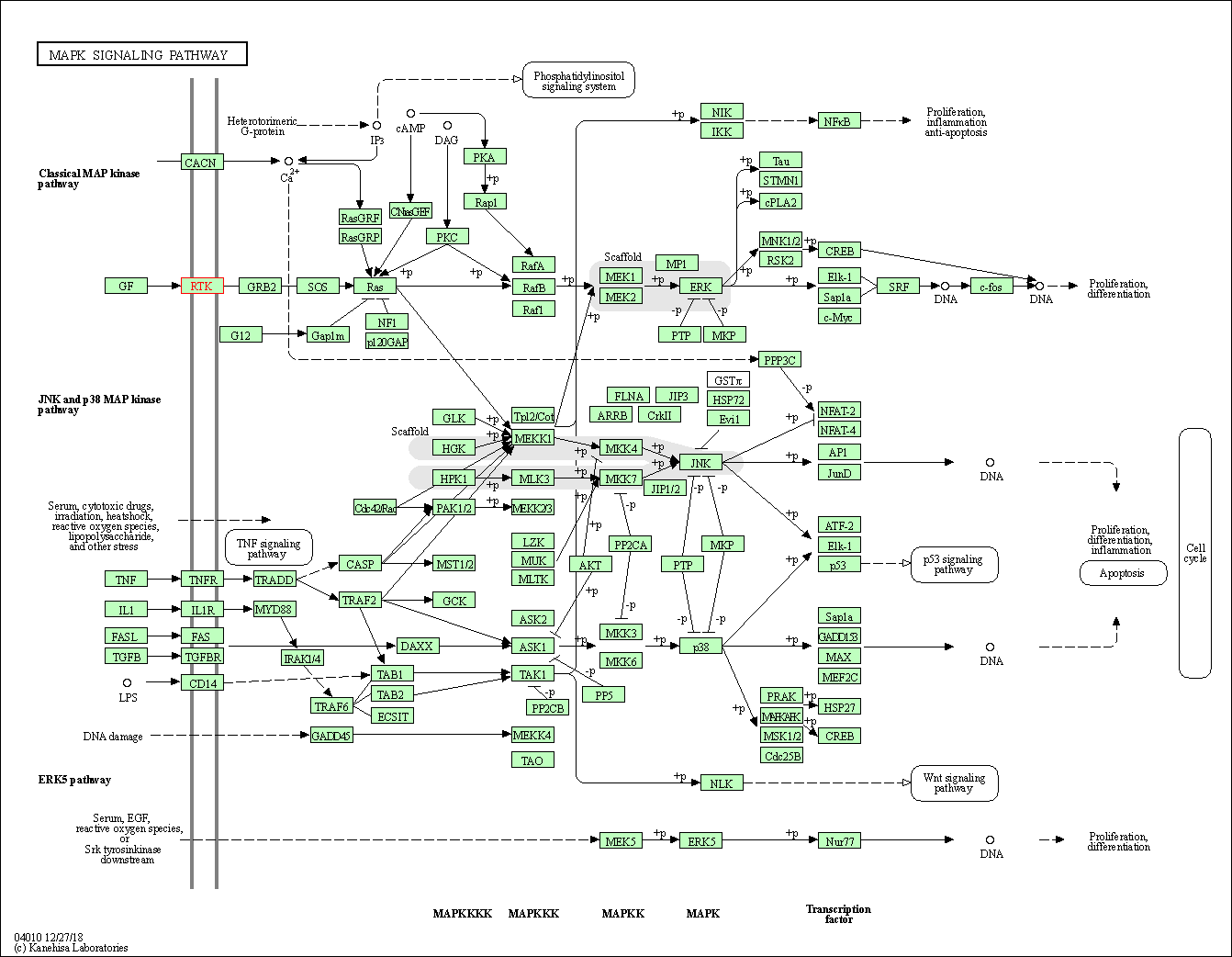
|
| Class: Environmental Information Processing => Signal transduction | Pathway Hierarchy | ||
| Ras signaling pathway | hsa04014 | Affiliated Target |
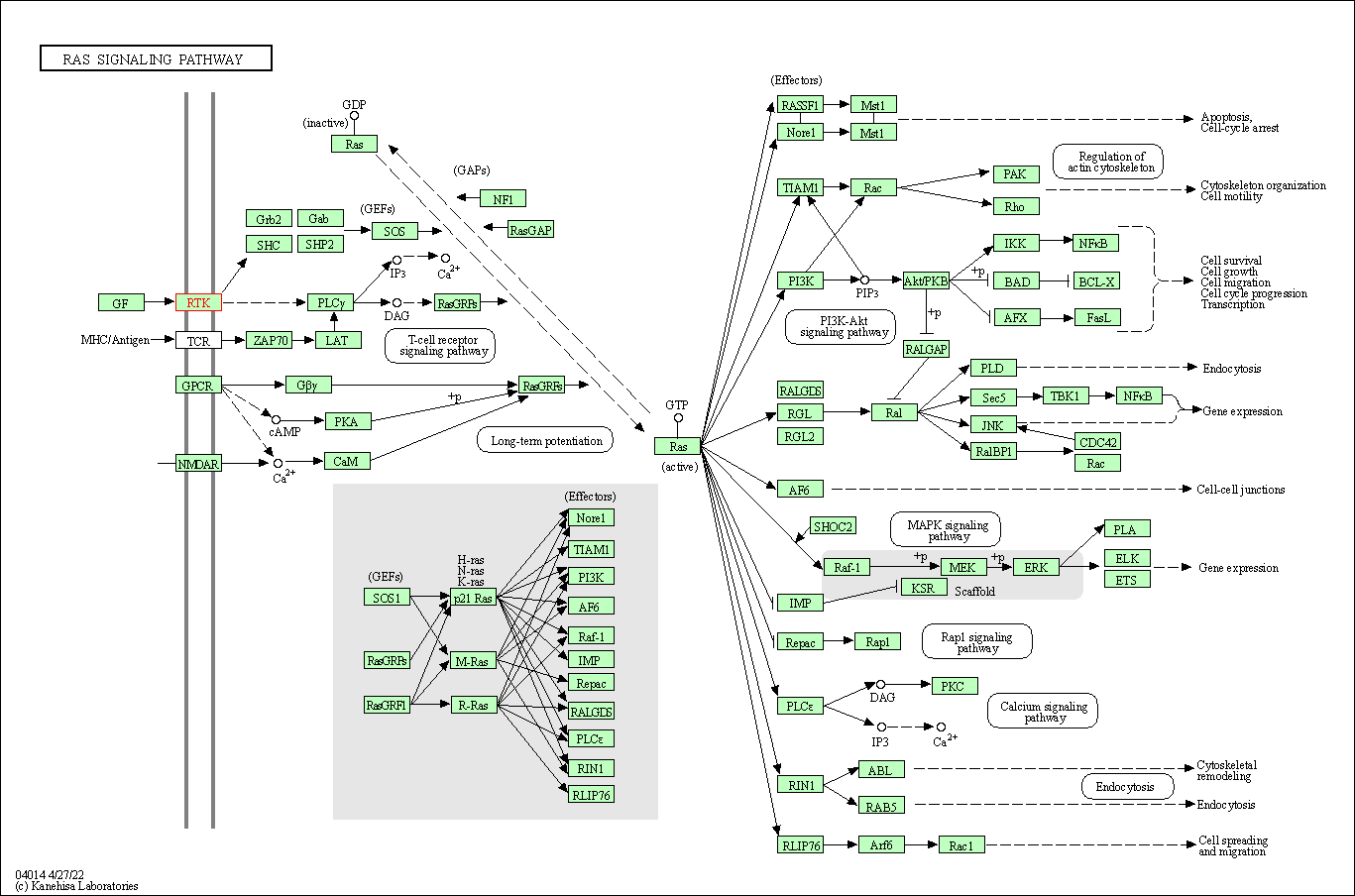
|
| Class: Environmental Information Processing => Signal transduction | Pathway Hierarchy | ||
| Calcium signaling pathway | hsa04020 | Affiliated Target |
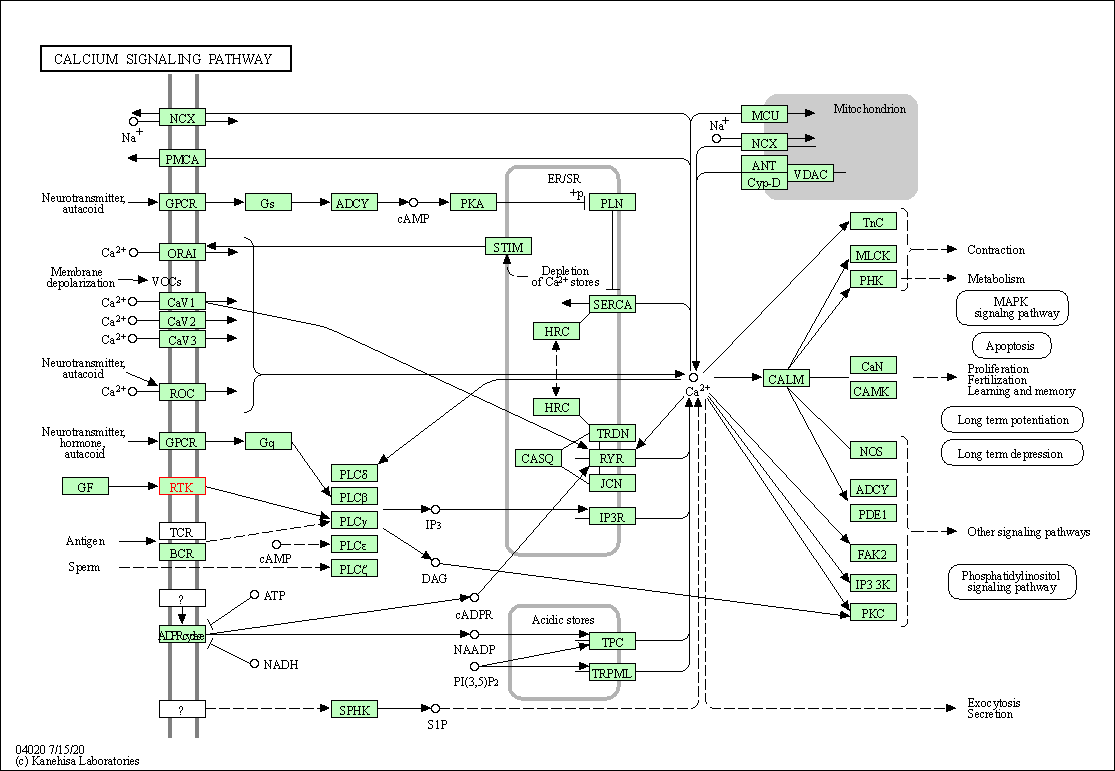
|
| Class: Environmental Information Processing => Signal transduction | Pathway Hierarchy | ||
| PI3K-Akt signaling pathway | hsa04151 | Affiliated Target |
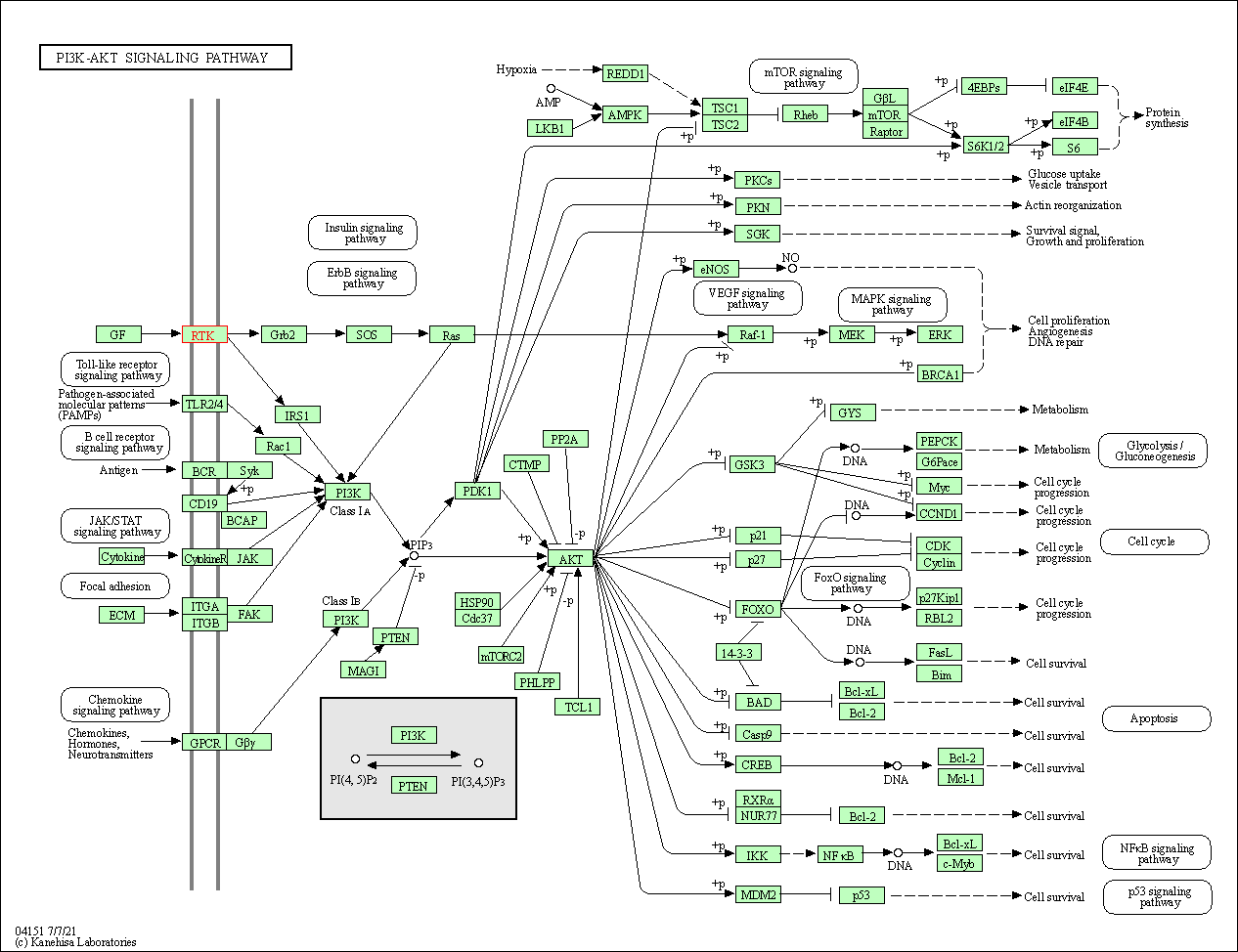
|
| Class: Environmental Information Processing => Signal transduction | Pathway Hierarchy | ||
| Neurotrophin signaling pathway | hsa04722 | Affiliated Target |
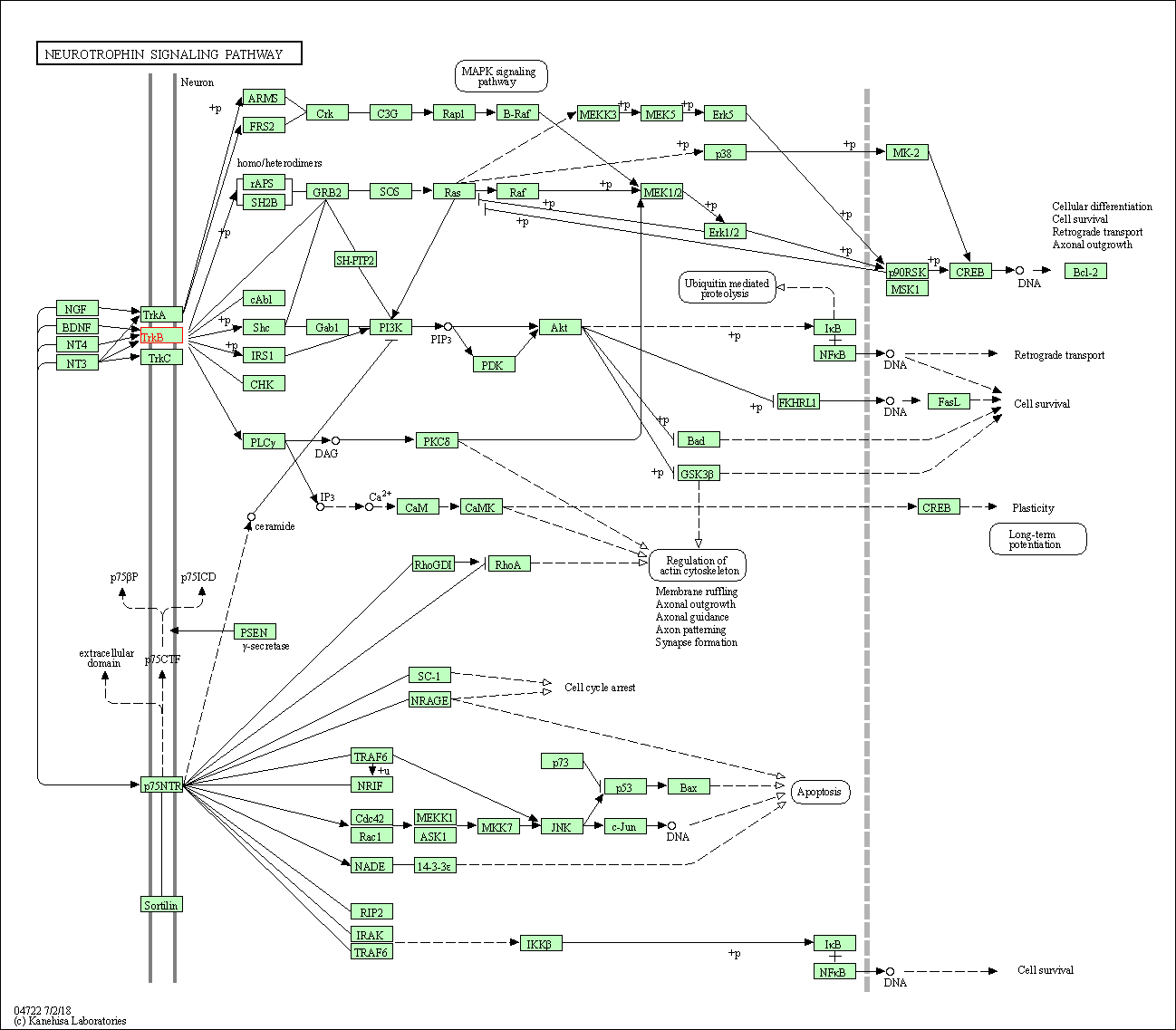
|
| Class: Organismal Systems => Nervous system | Pathway Hierarchy | ||
| Degree | 20 | Degree centrality | 2.15E-03 | Betweenness centrality | 7.22E-04 |
|---|---|---|---|---|---|
| Closeness centrality | 2.42E-01 | Radiality | 1.42E+01 | Clustering coefficient | 1.47E-01 |
| Neighborhood connectivity | 4.07E+01 | Topological coefficient | 8.12E-02 | Eccentricity | 11 |
| Download | Click to Download the Full PPI Network of This Target | ||||
| Chemical Structure based Activity Landscape of Target | Top |
|---|---|
| Drug Property Profile of Target | Top | |
|---|---|---|
| (1) Molecular Weight (mw) based Drug Clustering | (2) Octanol/Water Partition Coefficient (xlogp) based Drug Clustering | |
|
|
||
| (3) Hydrogen Bond Donor Count (hbonddonor) based Drug Clustering | (4) Hydrogen Bond Acceptor Count (hbondacc) based Drug Clustering | |
|
|
||
| (5) Rotatable Bond Count (rotbonds) based Drug Clustering | (6) Topological Polar Surface Area (polararea) based Drug Clustering | |
|
|
||
| "RO5" indicates the cutoff set by lipinski's rule of five; "D123AB" colored in GREEN denotes the no violation of any cutoff in lipinski's rule of five; "D123AB" colored in PURPLE refers to the violation of only one cutoff in lipinski's rule of five; "D123AB" colored in BLACK represents the violation of more than one cutoffs in lipinski's rule of five | ||
| Co-Targets | Top | |||||
|---|---|---|---|---|---|---|
| Co-Targets | ||||||
| Target Poor or Non Binders | Top | |||||
|---|---|---|---|---|---|---|
| Target Poor or Non Binders | ||||||
| Target Regulators | Top | |||||
|---|---|---|---|---|---|---|
| Target-regulating microRNAs | ||||||
| Target-interacting Proteins | ||||||
| Target Profiles in Patients | Top | |||||
|---|---|---|---|---|---|---|
| Target Expression Profile (TEP) | ||||||
| Target Affiliated Biological Pathways | Top | |||||
|---|---|---|---|---|---|---|
| KEGG Pathway | [+] 3 KEGG Pathways | + | ||||
| 1 | MAPK signaling pathway | |||||
| 2 | Neurotrophin signaling pathway | |||||
| 3 | Alcoholism | |||||
| PID Pathway | [+] 3 PID Pathways | + | ||||
| 1 | SHP2 signaling | |||||
| 2 | Posttranslational regulation of adherens junction stability and dissassembly | |||||
| 3 | Neurotrophic factor-mediated Trk receptor signaling | |||||
| Reactome | [+] 1 Reactome Pathways | + | ||||
| 1 | NGF-independant TRKA activation | |||||
| WikiPathways | [+] 2 WikiPathways | + | ||||
| 1 | SIDS Susceptibility Pathways | |||||
| 2 | BDNF signaling pathway | |||||
| References | Top | |||||
|---|---|---|---|---|---|---|
| REF 1 | 2018 FDA drug approvals.Nat Rev Drug Discov. 2019 Feb;18(2):85-89. | |||||
| REF 2 | Drugs@FDA. U.S. Food and Drug Administration. U.S. Department of Health Human Services. 2019 | |||||
| REF 3 | Clinical pipeline report, company report or official report of the Pharmaceutical Research and Manufacturers of America (PhRMA) | |||||
| REF 4 | MK-2461, a novel multitargeted kinase inhibitor, preferentially inhibits the activated c-Met receptor. Cancer Res. 2010 Feb 15;70(4):1524-33. | |||||
| REF 5 | Tropomyosin receptor kinase inhibitors: an updated patent review for 2010-2016 - Part II.Expert Opin Ther Pat. 2017 Jul;27(7):831-849. | |||||
| REF 6 | Tropomyosin receptor kinase inhibitors: an updated patent review for 2010-2016 - Part I.Expert Opin Ther Pat. 2017 Jun;27(6):733-751. | |||||
| REF 7 | URL: http://www.guidetopharmacology.org Nucleic Acids Res. 2015 Oct 12. pii: gkv1037. The IUPHAR/BPS Guide to PHARMACOLOGY in 2016: towards curated quantitative interactions between 1300 protein targets and 6000 ligands. (Target id: 1818). | |||||
| REF 8 | Discovery of GNF-5837, a Selective TRK Inhibitor with Efficacy in Rodent Cancer Tumor Models. ACS Med Chem Lett. 2012 Jan 1;3(2):140-5. | |||||
| REF 9 | Design of potent and selective inhibitors to overcome clinical anaplastic lymphoma kinase mutations resistant to crizotinib. J Med Chem.> 2014 Feb 27;57(4):1170-87. | |||||
| REF 10 | The crystal structures of TrkA and TrkB suggest key regions for achieving selective inhibition. J Mol Biol. 2012 Oct 26;423(3):439-53. | |||||
If You Find Any Error in Data or Bug in Web Service, Please Kindly Report It to Dr. Zhou and Dr. Zhang.

